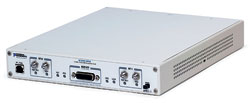Wireless consumers’ growing demand for data on mobile devices and increased dependence on applications or “apps” have spurred unprecedented levels of research to design the next generation of wireless systems to increase network capacity while offering new capabilities. The faster a researcher can transition a concept from design to a working prototype, the faster all of us ultimately benefit from faster data at our fingertips and new applications that take advantage of new network capabilities. Researchers are relying more and more on software defined radios (SDR) to compress the time to prototype, and they are becoming integral tools in the design flow. With SDRs, researchers can rapidly prototype custom protocols, analyze concept performance in real-world environments, and iterate. SDRs closely mirror the functionality found in real wireless devices with the added flexibility of broader frequency coverage and reprogrammable baseband processing. The more capable the SDR, the broader the array of research topics that can be explored.

Figure 1 The NI USRP RIO joins a complete product line of NI RF technology that features a common NI LabVIEW development framework, spanning from design to test.
The NI USRP RIO family of software defined radios sets a new standard in price, performance and productivity. NI USRP RIO features a flexible, high performance 2×2 MIMO RF front end with a large reconfigurable Xilinx 7 series FPGA for DSP processing – all in a compact form factor. Tightly integrated NI LabVIEW software support accelerates system design by providing a seamless tool chain that allows researchers to design and deploy algorithms across the FPGA and host processor. Users can balance implementation to match the needs of their application. Designed for rapid prototyping, NI USRP RIO (see Figure 1)is accelerating next-generation wireless research and making users more efficient by enabling them to bridge their software tool flow from design through verification and test.
Designed for Rapid Prototyping
The integrated hardware and software design flow, termed the NI LabVIEW Reconfigurable I/O (RIO) architecture, allows communications system engineers to more rapidly prototype their designs. These engineers can now fulfill the role of system architect, baseband DSP designer and high performance FPGA integrator within a common framework for higher bandwidth and lower latency wireless applications. The NI USRP RIO provides two direct conversion RF transceivers with frequency tuning options from 50 MHz to 6 GHz and up to 40 MHz of instantaneous real-time bandwidth. Designers can customize baseband processing in the large DSP-oriented Xilinx Kintex 7 410T FPGA for high performance algorithm implementation that might include channelization or implementation of an entire physical layer of a protocol. NI LabVIEW FPGA software accelerates FPGA design through an open intuitive graphical dataflow representation while allowing native HDL to be integrated inline as needed. NI USRP RIO connects to the host PC over a low-latency PXI Express ×4 connection where LabVIEW, C and m-file script code can be integrated into LabVIEW for host-based processing. Designers can prototype on the latest wireless hardware without the expense of maintaining in-house prototyping platforms as they design next-generation systems.
Next-Generation Wireless Research
An NI USRP RIO scales from simple monitoring or single-input, single-output (SISO) link applications to high-channel-count multi-antenna research. The NI USRP-294xR devices include a TCXO, while the NI USRP-295xR devices integrate a GPS disciplined OCXO precision clock for improved frequency accuracy and synchronization. Two devices (4 channels) conveniently mount into a single 1U rack with SMA ports on the back for distributing clocks and triggers among multiple devices. The scalability of the platform and productivity gains from LabVIEW allow researchers to make significant contributions across a broad range of applications that include Wi-Fi, LTE, cognitive radio, massive multiple-input, multiple-output (MIMO), spectrum monitoring, Internet of Things (IoT), Global Navigation Space Systems (GNSS), radar, satellite communications and more.

Figure 2 With the power of the NI LabVIEW RIO architecture, this SDR will open new avenues into communication system design.
Prototyping is becoming increasingly important as researchers seek new ways to meet consumers’ insatiable need for bandwidth. At Lund University in Sweden, researchers Ove Edfors and Fredrik Tufvesson are working to build one of the first massive MIMO test beds. With more than 100 antennas, this prototype is the largest and most comprehensive of its kind, making it the first test bed to reach this level of magnitude and complexity on the road to 5G.
Complete Platform from Design to Test
NI USRP RIO joins a complete product line of NI RF technology that features a common NI LabVIEW development framework (see Figure 2). This makes it possible for engineers to collaborate more freely throughout the design process. Design teams benefit from the unified software tool flow, which enables code reuse and collaboration from early stages of design, to characterization, and to manufacturing test. Furthermore, because NI’s hardware architecture is similar throughout its RF products, prototypes developed on software defined radio hardware can be deployed on high-performance RF test instrumentation with NIST tractable calibration.
Together, the NI USRP RIO and LabVIEW platform set a new standard for price, performance and productivity, which enhances researchers’ ability to prototype next-generation wireless systems. This ultimately makes it possible to meet the growing demand for next-generation wireless technologies.
National Instruments,
Austin, TX,
www.ni.com/sdr
